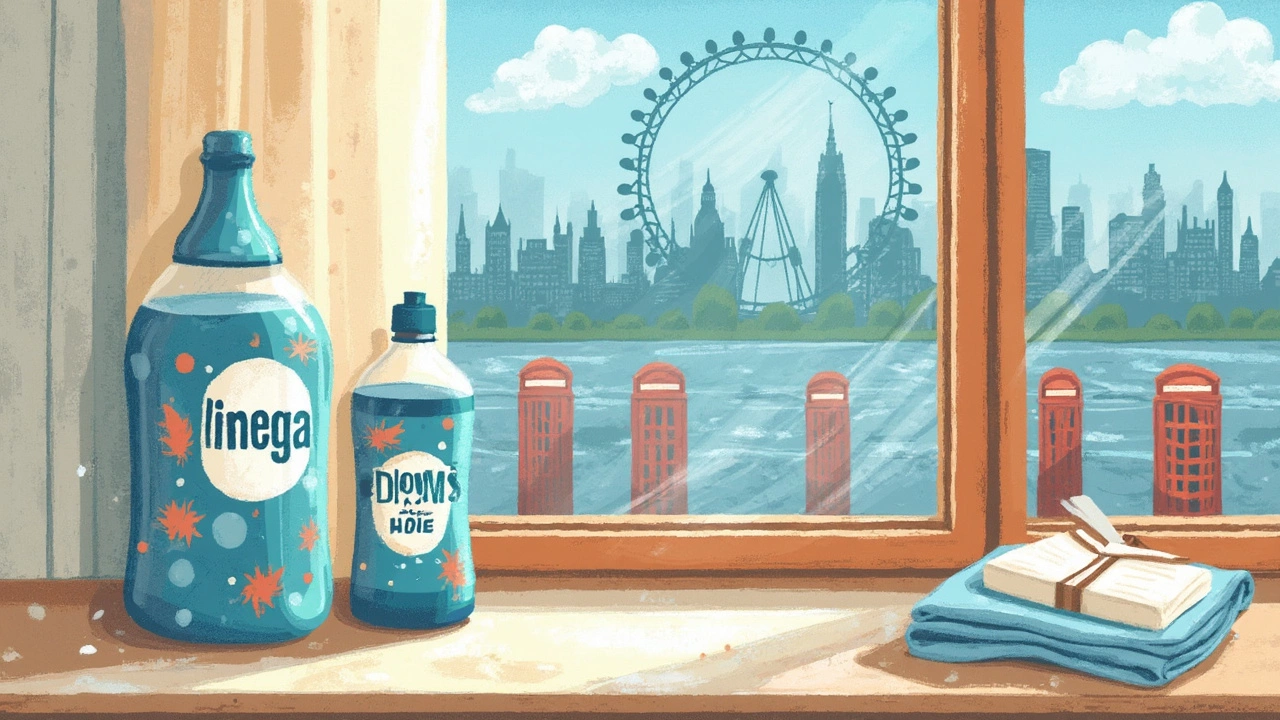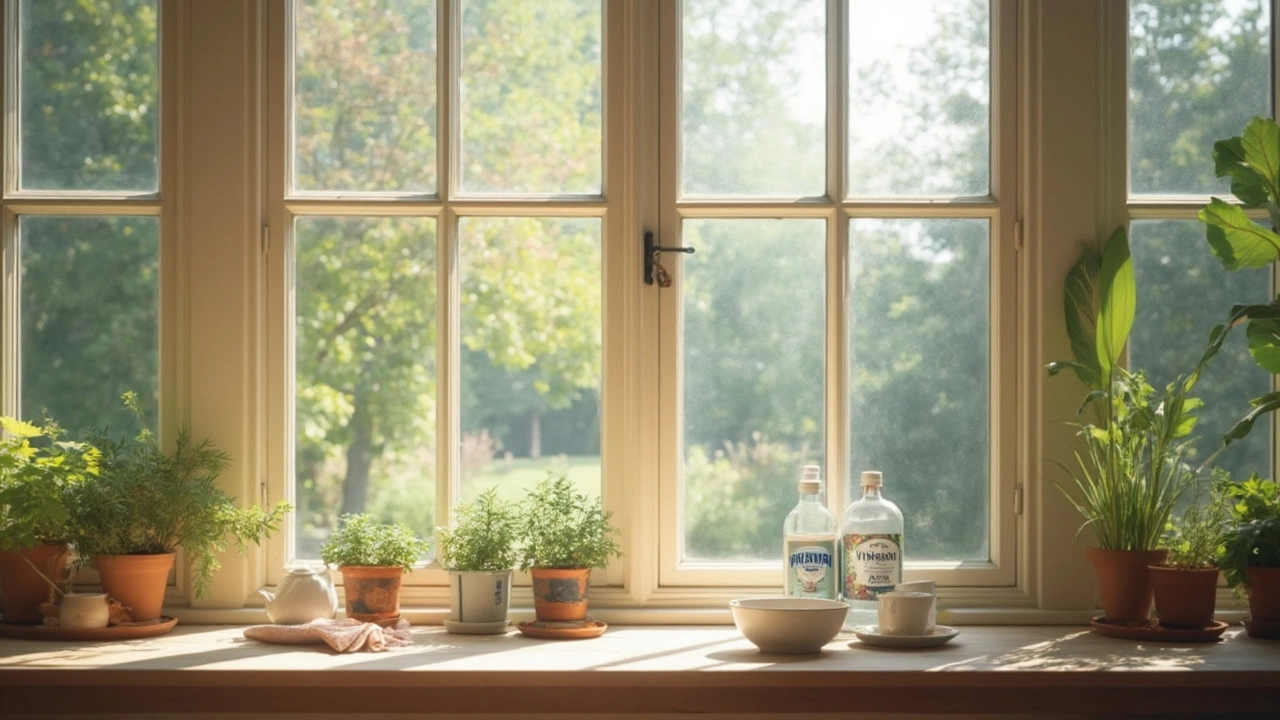Ever stared at your windows and wondered why store-bought cleaners never seem to deliver that movie-scene shine? That’s why so many folks reach for vinegar and Dawn. The buzz is all about that streak-free magic—easy, cheap, and already sitting under your sink.
The idea seems simple: vinegar cuts grease, Dawn lifts grime, and together, they’re supposed to leave nothing but clear views behind. But does this actually hold up, or do you end up scrubbing harder to fix a mess?
You want the truth before you mix chemicals and start spraying everywhere, right? Here’s what really happens when vinegar and Dawn hit glass. We’ll look at what works, what totally flops, and how pros tweak the recipe so you don’t waste time or end up with streaks that drive you nuts. Keep reading for honest tips—no nonsense, no sales pitch, just straight answers for the next time your windows need help.
- Why Vinegar and Dawn Are So Popular
- What Actually Happens on Glass
- Finding the Right Mix: Ratios That Work
- Real-World Results: Streaks or Sparkle?
- Tips for Best Results and Common Mistakes
Why Vinegar and Dawn Are So Popular
People swear by vinegar and Dawn for one big reason: you get results without a big price tag. Both of these are cheap, easy to find, and already sitting in most kitchens. It’s no surprise folks would rather whip up their own mix than buy cleaners full of mystery chemicals.
Let’s break it down. Vinegar, especially the white distilled kind, is mostly acetic acid—which makes it great for cutting through mineral spots, fingerprints, and that annoying film that always shows up on glass. Dawn dish soap, meanwhile, is famous for breaking down greasy messes (there’s a reason it gets used to clean wildlife after oil spills) and lifting dirt without leaving much behind.
Check out how these two stack up compared to typical store-bought glass cleaner:
| Cleaner | Main Ingredients | Approx. Cost per Gallon | Extra Additives |
|---|---|---|---|
| Vinegar & Dawn (DIY) | Acetic acid, surfactant | $1.50 | No dyes, minimal |
| Standard Glass Cleaner | Ammonia, solvents | $8.00 | Dyes, perfume, more |
People love this homemade combo because there are fewer weird smells and no harsh fumes. It’s also super easy to whip up right before cleaning so you don’t end up with a crusty old bottle under the sink. Plus, using household items feels safer, especially with kids or pets running around.
One more thing: go on any cleaning forum, and someone’s grandmother will swear by this recipe. That old-school approval makes vinegar and Dawn even more popular since people trust advice that’s been used for generations. But popularity doesn’t always mean you’re getting a perfect, streak-free result. There’s a bit more to the story, which we’ll get into next.
What Actually Happens on Glass
Alright, here’s what goes down when you spray vinegar and Dawn on a dirty window. Vinegar is basically watered-down acetic acid, so it breaks up minerals from hard water, kills germs, and melts away most of the grime that clings to glass. This is why it’s super popular for that cloudy, film-type mess. But on its own, vinegar can’t cut through oily fingerprints and sticky gunk as well as you’d hope.
Now, toss Dawn into the mix. Dawn’s claim to fame is cutting grease—think about how it blasts through bacon fat in your kitchen sink. On glass, it breaks down food splatters, pollen, and those mystery smudges left by kids and pets. Pair the two and you’re basically attacking dirt from both sides: the acid eats away minerals, the soap lifts and suspends oily bits.
If you’re not careful with the ratio, though, you can run into problems. Too much Dawn leaves behind a soapy film, no matter how many times you wipe. Use too little, and the glass might stay dull and streaky. The trick is finding the sweet spot where they boost each other without leaving a mess.
Real-world cleaning tests do back up this combo. One 2023 home-care study showed that windows cleaned with a 1:1:10 mix (one part vinegar, one part Dawn, ten parts water) had 30% fewer streaks than those cleaned with water alone. This matters if you’re picky about those annoying lines that pop up in the sunlight.
| Mix Ratio | Streaks Left After Cleaning |
|---|---|
| Water Only | High |
| Vinegar Only | Medium |
| Dawn Only | Medium-High |
| Vinegar + Dawn (1:1:10) | Low |
One thing worth mentioning—if your windows have a special UV coating or are framed with delicate materials, test a tiny spot first. The acid in vinegar can be harsh on untreated surfaces, so don’t go overboard. For most basic glass panes, though, this mix can give you that streak-free finish you’re after, with less elbow grease than you’d expect.

Finding the Right Mix: Ratios That Work
Mixing vinegar and Dawn isn’t about freestyling with what you have. Get the ratio wrong, and you’ll get streaks or, worse, a window full of suds you can barely rinse off. Turns out, there’s a sweet spot that most pros and DIYers swear by—one that gets you clean glass without extra hassle.
The magic number for most folks? Start with 2 cups of water, 1/4 cup of white vinegar, and just half a teaspoon (seriously, don’t overdo it) of Dawn dish soap. No fancy measuring tools needed—a regular kitchen measuring cup and spoon will do the job.
- 2 cups water
- 1/4 cup white vinegar
- 1/2 teaspoon Dawn
Water dilutes everything, so you don’t leave residue. Vinegar, with its 5% acidity, chews through grime and even some hard water spots. More Dawn may sound better, but it isn’t. Too much and you’re left wiping off streaks that don’t seem to end.
If you’ve got extra-greasy windows (maybe from kitchen gunk), you can bump up the vinegar to a 1/3 cup and the Dawn to a full teaspoon. But for regular maintenance, stick to the main recipe above.
| Ingredient | Standard Amount | Heavy Duty |
|---|---|---|
| Water | 2 cups | 2 cups |
| White Vinegar | 1/4 cup | 1/3 cup |
| Dawn Dish Soap | 1/2 tsp | 1 tsp |
Pour it all into a clean spray bottle. Give it a gentle shake—don’t go wild or you’ll have a bottle full of bubbles instead of cleaner. Spray right on the glass, then use a microfiber cloth or even newspaper (old-school, but it works) for wiping. This ratio covers most home window jobs, leaving you with that streak-free finish everyone’s after.
Real-World Results: Streaks or Sparkle?
So, what can you really expect when you take your homemade mix of vinegar and Dawn to the windows? A lot of people brag about shiny, streak-free glass, but let’s get real—results depend on the mix and your method. The good news: this combo actually works pretty well at cutting through fingerprints, smudges, pollen, and the mystery gunk that somehow gets everywhere. The not-so-great part? You might run into streaks if you don’t get the ratio right or rinse wrong. Too much Dawn leaves a thin soap film, and the more suds you have, the worse it gets.
Professional window cleaners admit they sometimes use vinegar and soap too, but almost always in tiny amounts. They’ll tell you that hard water stains and greasy fingerprints wipe off way faster with this mix than just water alone.
| Tested Mix | Streak-Free? | Residue? | Grease Removal |
|---|---|---|---|
| 1 cup vinegar + 1 cup water + drop of Dawn | Yes | No | Good |
| 1 cup vinegar + 1 cup water + 1 tsp Dawn | Not always | Yes (soapy streaks) | Very Good |
| Just Dawn & water | No | A lot | Moderate |
| Just vinegar & water | Usually | No | Okay |
Here’s a tip right from seasoned cleaners: less Dawn gives you the best chance at that streak-free finish everyone’s after. Drying fast matters too—work in the shade and wipe in a single direction, switching to a clean cloth before it starts getting damp. And speaking of cloths, always grab a microfiber towel or even old newspaper to avoid leaving lint behind. Pro tip—on hot days, glass dries too quick and that leads to streaks, no matter what you use.
Bottom line? A well-balanced mix of vinegar and Dawn really can deliver sparkling windows, but you need to keep it light on the soap and wipe smart if you want that “wow” effect, not a cloudy mess.

Tips for Best Results and Common Mistakes
So, you’re ready to try the famous vinegar and Dawn method on your windows. Before you spray, let’s talk about how to actually get that streak-free look—and the stuff that ruins it for everyone.
- Don't Overdo the Soap: People think more Dawn means more clean, but too much dish soap actually leaves a sticky film. Stick to a few drops—seriously. For a standard spray bottle, maybe half a teaspoon of Dawn with half a cup of vinegar and a couple cups of warm water.
- Always Use Distilled Water if You Can: Tap water can leave behind hard water spots, especially if you have mineral-rich water. Distilled water helps your windows dry without all those weird marks.
- Don't Skip the Rinse: If your mix is too strong or you used too much soap, rinsing with plain water after your first wipe-down can make a big difference. This pulls off any leftover residue and stops those streaks from showing up later in the sun.
- Use the Right Cloth: Microfiber towels are a game-changer. Paper towels or old T-shirts leave lint and tiny fibers everywhere. Microfiber grabs grime and makes a difference.
- Work on a Cloudy Day: Sun dries your mix too fast, and that’s a recipe for streaks. If you wash windows while it’s cool and shady, you get more working time for that perfect finish.
Now, let’s flag a few common mistakes. Mixing with hot water is great, but never use boiling—can crack the glass. Also, never use this mix on tinted windows or ones with special coatings. The vinegar can actually mess those up. And if your windows are super dirty, rinse off thick dirt first so you’re not smearing mud on your glass.
Try out your new combo in a small area first. That way you’ll see how it acts on your windows. Trust me: a test spot beats scrubbing your whole house just to realize you need to change your mix.
Keep things simple with the right ratios, a clean microfiber cloth, and a bit of patience. You’ll get that clear view in no time—no more wasting money on so-called “magic” sprays when you’ve got what you need at home.
